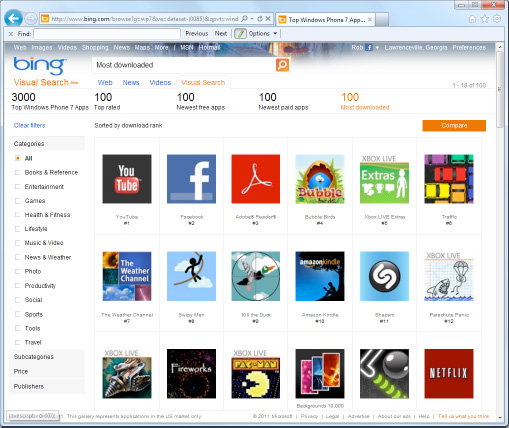There are many reasons a developer like you
wants to build an application for Windows Phone 7. To make your
creation available to customers, you submit it for certification to the
Windows Marketplace for Mobile, which is the official name. Henceforth,
we will refer to it as the Windows Phone Marketplace.
1. Windows Phone Marketplace Registration
Registering for the Windows Phone Marketplace is a straightforward process, which you can do at AppHub here: http://create.msdn.com.
Registration takes some time to fully complete because Microsoft vets
every publisher identity via GeoTrust. The timeline is partially
dependent on actions by you, such as clicking the email link to
validate your email address and providing the necessary documentation
to GeoTrust in a timely manner
Publisher Verification ensures that consumers can
feel confident that the publisher is who they say they are. This
protects the consumer from a nefarious publisher impersonating their
bank as a way to obtain a user's account information.
Registration costs $99. This allows you as the
publisher to submit an unlimited number of for pay applications and
five free app certifications. As of this writing, each additional
certification event is $20 per application. Updates to free
applications are no-charge certification events unless the application
fails certification during the update.
|
If you are a member of one of Microsoft's "Spark"
programs such as BizSpark for startup business or DreamSpark for the
academic community, you may be eligible for a reduced or possibly free
Marketplace registration.
|
|
Microsoft is continuously updating policies to
better serve its developer community. The AppHub FAQ is a great place
to start for the most recent updates: http://create.msdn.com/en-US/home/faq.
2. Submitting Applications to Marketplace
When you submit an application to Marketplace, the
estimated average time for an application to be approved is five days.
Microsoft validates the application against the criteria set forth in
the document "Windows Phone 7 Application Certification Requirements"
available for review at http://create.msdn.com. This document covers application policy guidelines, content policy guidelines, and application certification requirements.
2.1. Making Money
The application publisher sets the price of the
application. As the publisher you collect 70% of the revenue and
Microsoft keeps 30% for paid applications, which is in line with other
application store revenue models. The 30% primarily covers the costs of
marketplace, certification costs, and so on.
Microsoft also provides an advertising-based revenue
model offering for Windows Phone 7. You are not required to use
Microsoft's advertising offering but it does provide a very easy way to
take advantage of advertising revenue.
An important component to getting paid is potential
application reach. At initial availability, Windows Phone 7 currently
support 5 languages; English, French, Italian, German and Spanish,
otherwise known as EFIGS. The Windows Phone Marketplace supports
applications purchases in 30 countries as of this writing with more
countries to be added in 2011.
Australia
Austria
Belgium
Brazil
Canada
Denmark
Finland
France
Germany
Greece
Hong Kong
India
Ireland
Italy
Japan
Luxembourg
Mexico
Netherlands
New Zealand
Norway Poland
Portugal
Russia
Singapore
Spain
Sweden
Switzerland
Taiwan
United Kingdom
United States
In order to participate and sell your applications
and get paid, you must be registered in Marketplace and have a bank
account for one of these countries. Microsoft announced early in 2011
that more countries and languages will be added later this year. Go to http://create.msdn.com/en-US/home/faq/windows_phone_7#wp7faq53 to check on supported countries for the latest status.
2.2. Marketing Matters
Making money is more than setting a price. As part
of the submission process, the developer supplies the detailed
description, screen shots, and marketing art for items like the
background panorama for the Marketplace hub. Your tile icon is
determined by the background.png file that is part of your
Visual Studio Windows Phone 7 project so be sure to update it so that
it looks good on the Windows Phone 7 Start screen. The applicationicon.png file is the smaller icon displayed in the App List. Figure 1 shows the App List in the emulator.

The marketing art for Marketplace is incredibly
important because that is what the end-user sees when viewing your
application in Marketplace on the device. Also, if you study successful
applications on other platforms, the mobile ISV generally includes four
people or roles, a business person, a marketing person, and a couple of
developers. Someone has to wear the marketing hat to promote the
application beyond Windows Phone Marketplace, such as via Social
Networking channels, outreach to application review web sites, and so
on. The most successful applications are those with a great business
plan and great marketing behind them.
3. Bing Visual Search for Windows Phone 7
Not really an official web marketplace, however, the
Bing Maps Visual Search provides a visual filterable search for the top
3000 applications. To review the search go to http://bing.com and enter Windows Phone 7 Top Apps. A new menu appears under the search box titled "visual search." Click it to bring up the results as shown in Figure 2.

You can filter the search by category on
the left as well as filter using the headers across the top such as 100
Newest paid apps, and so on. Clicking on an application or game
provides additional details on the application as well as a deep link
for the Windows Phone 7 desktop marketplace, which is covered in the
next section.